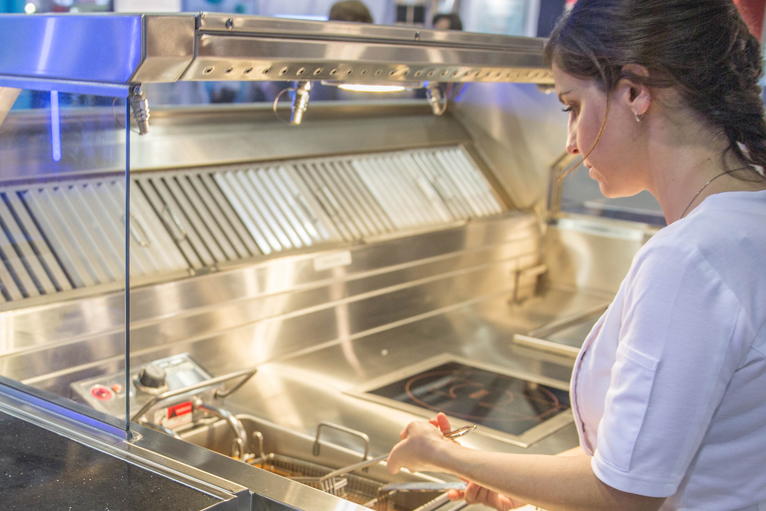When designing a kitchen ventilation system, there may be a location where it is not cost-effective to run ductwork to the exterior of the building. This approach should always be the first consideration. In the absence of a practical means of ducting the kitchen exhaust, a ventless solution also known as a ductless solution can be a viable alternative.
Ductless systems are listed to a different standard than ducted systems. The ducted systems listing standard for exhaust hoods is UL 710. Ductless systems are listed to UL 710B. The critical difference in the criteria is to measure emissions from ductless systems. Those emissions are measured per standard EPA 202. The allowable level for particulate for ductless systems is 5mg per cubic meter of air. When designing or testing for a specific appliance, in practical terms, the first step is to measure the baseline emissions from the appliance to determine filtration requirements. Combi ovens, for example, may have emissions lower than the standard without any additional filtration. This has implications for further filtration or fire system requirements. In this instance, an appliance may be installed under a Type II hood per applicable code or coupled with a listed commercial cooking accessory to operate in recirculating mode.
When additional filtration is required, the appliance will follow the UL 710B prescribed certification path, including emissions testing, fire suppression, and appliance interlocking to ensure proper operation.
If the ductless device can be applied to multiple cooking combinations, the device is tested for emissions under worst-case conditions. UL 710B defines the testing protocol for fryers, griddles, char-broilers, and ovens. Provisions are made for product-specific applications as well.
An excerpt from the standard details the food product to be tested based on appliance:

Ductless ventilation systems generally fall into a few categories.
- Close coupled to a specific appliance. This means the ductless hood was tested specifically for use with a particular appliance. This can be a family of appliances, such as a combi oven, of various sizes.
- A more flexible design is one where a ductless system has been approved for a number of appliances up to a specific cooking surface area and connected power (kw rating)
- A mobile device that is self-contained and can come with a variety of appliances up to a maximum length based on its listing, connected power, and amp draw.
- A fixed device with a filter tower and integrated exhaust hood. These are listed in a similar manner for a specific range of appliances and connected power.
- A remote filter tower that can be connected to a UL 710 listed exhaust hood.
Some general design guidelines that should be adhered to for ventless solutions;
- Verify minimum square footage required to install a ductless hood based on the manufacturers listing.
- There is sufficient outdoor air to meet all building code requirements. Confirm with your local authority for any requirements outside of the standard.
- Speaking of Authority Having Jurisdiction (AHJ), not every municipality allows for recirculating hoods. Even when a system is listed to the proper standard, it is important to verify they are allowed.
- Some locations require local approval, such as New York City. In New York City, a separate approval for a Certificate of Acceptance (COA) is necessary to install a ductless system. Check with the manufacturer for such a document.
- Since the exhaust is being recirculated, it adds additional load (heat) to space. Depending on the size, your system may require additional cooling to offset. Check with the manufacturer on the proper sizing of this supplemental cooling.
Should your application require a ventless solution, the experts that manufacture these types of systems can guide you on the proper selection and any accessories needed to meet the local requirements.
Read other articles relating to Code Issues and Updates
Other articles relating to commercial kitchen exhaust hoods:
Subscribe to kitchenventilation.com
Stay up to date by subscribing to Halton’s Commercial Kitchen Ventilation Blogs by entering your email address to subscribe and Halton will provide you with the latest information on commercial kitchen exhaust hoods, pollution control units, air handling, and safety systems. You will receive notifications of new posts by email.


Comments
2 responses to “Advantages and Limitations of Ventless Solutions for Commercial Kitchen Ventilation”
[…] Read another article relating to Recirculating or Ventless Solutions for Commercial Kitchen Ventilation – Advantages and Limitations of Ventless Solutions for Commercial Kitchen Ventilation […]
[…] article relating to Recirculating or Ventless Solutions for Commercial Kitchen Ventilation – Advantages and Limitations of Ventless Solutions for Commercial Kitchen Ventilation or New Approaches For Recirculating Systems in Kitchen […]